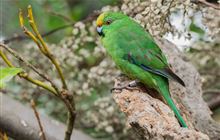Pukenui/Anchor Island proposed as next kākāriki karaka translocation site
Introduction
Kākāriki karaka/orange-fronted parakeet, New Zealand’s rarest parakeet species, may soon call Pukenui/Anchor Island home.Date: 10 August 2023
The predator-free island, in Fiordland’s Tamatea/Dusky Sound, is proposed as a site for a fifth wild population for the critically endangered taonga species, with hopes kākāriki karaka could be released there from spring 2024.
With the support of Kaitiaki Rōpū ki Murihiku, representatives from the Kākāriki Karaka Recovery Groupwill soon visit Pukenui to assess the forests and infrastructure, as part of the mahi underway to check the island’s suitability for the taonga species.
It would be a significant step forward for the species’ recovery programme, run in partnership by DOC and Te Rūnanga o Ngāi Tahu.
Kaitiaki Rōpū ki Murihiku represents the four southern Ngāi Tahu Papatipu Rūnanga who hold mana whenua over Pukenui. Kaumātua Michael Skerrett says the rōpū is very supportive of the proposal to explore the island as potential habitat for kākāriki karaka.
“Habitat loss and predation by introduced mammals has contributed to the extinction of too many native manu species already. We must do everything we can to exercise our kaitiakitanga and explore habitat opportunities like Pukenui to ensure the ones who remain can thrive.”
DOC Kākāriki Karaka Operations Manager Wayne Beggs says establishing more self-sustaining wild populations is a crucial part of the plan to ensure the species’ recovery.
“The captive breeding programme, run by The Isaac Conservation and Wildlife Trust and Orana Wildlife Park, does a fantastic job of raising lots of chicks for wild release each year, but we need more safe sites to release them.
“Our goal is to see kākāriki karaka thriving in the wild. The predator-free beech and rimu forest on Pukenui/Anchor Island should be a great site for kākāriki karaka to succeed.”
Wayne Beggs says this news is a fantastic lead up to Conservation Week, which runs from August 14.
Te Rūnanga o Ngāi Tahu kākāriki karaka representative Yvette Couch-Lewis has been working with the manu (birds) for more than twenty years. She hopes a potential move to Pukenui will help to stabilise the overall population.
“We are grateful for the support of our Murihiku whānau who tautoko our dream to create a safe haven for our taonga on Pukenui.”
A kākāriki karaka population was successfully established in the fenced Brook Waimārama Sanctuary near Nelson in 2021, which Yvette says shows the value of releasing the birds at predator-free locations.
“While we would prefer to keep our taonga safe within our Ngāi Tahu takiwā, suitable sites are becoming harder to find. It’s a reminder that we must work together to achieve a predator-free New Zealand where our manu can fly free.”
The kākāriki karaka recovery programme is supported by The Isaac Conservation and Wildlife Trust, Orana Wildlife Park, Canterbury University, Mainpower and the NZ Nature Fund.
Background information
Kaitiaki Rōpū Ki Murihiku represent the four southern Ngāi Tahu Papatipu Rūnanga: Te Rūnanga o Hokonui, Ōraka-Aparima Rūnaka, Waihōpai Rūnaka, and Te Rūnaka o Awarua.
With about 330 left in the wild, kākāriki karaka are the rarest mainland forest bird in Aotearoa.
They were once plentiful across the country, but proved an easy meal for introduced predators and were affected by habitat loss, which saw their numbers dwindle.
Because they nest and roost in holes in trees, kākāriki karaka are extremely vulnerable to rats, stoats and cats.
The species was twice declared extinct in the past (in 1919 and 1965) before being rediscovered in the late 1980s.
Anchor Island/Pukenui is already home to a range of threatened bird species including kākāpō.
Contact
For media enquiries contact:
Email: media@doc.govt.nz

